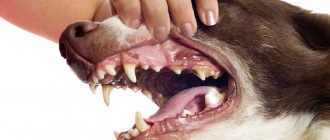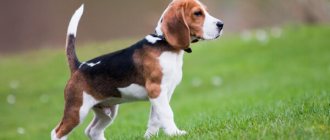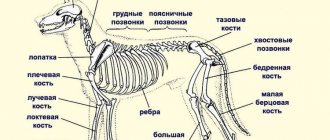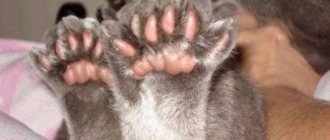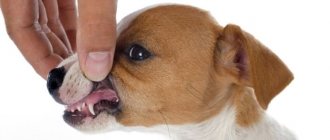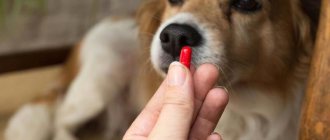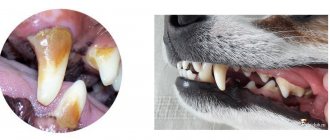Some dog owners do not think about the fact that their pet, like humans, has problems with teeth and gums, for example, they begin to become loose .
Toothache brings discomfort and a lot of trouble to four-legged friends and their owners. It is always easier to prevent a problem than to eliminate its consequences.
Main reasons
There is no smoke without fire. We suggest you understand the possible causes of loose teeth in dogs.
Changing dairy products to indigenous ones
When the puppy turns 3 months old, the period of teeth change begins. If at the age of about 3 months you notice that your pet’s teeth are loose, do not panic. The logical explanation here is that dairy products are replaced by permanent ones .
This process is explained by the fact that the rather long stone of the baby tooth is gradually crushed, weakened and pushed out by the growing tooth.
IMPORTANT! During this period, it is necessary to inspect the puppy's mouth daily.
What to do if a tooth that turns out to be a baby tooth is swaying? The owner can independently, with extreme care, loosen and pull it out using a sterile gauze pad.
However, when deviations from the norm are observed : the molars have already grown, but the milk teeth are still left, or the change of teeth has not yet begun at the indicated age, it is necessary to show the puppy to a specialist.
External manifestations
During this period, the puppy’s behavior changes noticeably: he begins to chew a lot, and, as a rule, everything in a row: things, furniture, shoes, bones, toys. This is how he tries to relieve pain and get rid of discomfort. In some cases added:
- general malaise;
- poor appetite;
- lethargy;
- disruptions in the digestive system;
- temperature increase.
Precautions
During the period of teeth change, the immunity of babies becomes not so strong. Therefore, provide the puppy with a calm regime: do not train him or walk him for a long time . Experts also do not recommend vaccinations. Take care of this in advance. To relieve discomfort, give your puppy a variety of toys that he can chew on and massage his gums.
Mechanical damage
A dog, by nature, is a very active and mobile animal. A loose tooth can be caused by mechanical damage after your pet chews on something excessively hard.
In this case, carefully examine the loose tooth for fractures or cracks . If any, immediately show your pet to a doctor to avoid complications.
Diseases
The causes of loose teeth in dogs can be various diseases .
Periodontitis
Inflammation of the tissues at the base of the teeth. This disease occurs most often. Periodontitis is manifested by the presence of plaque or tartar, and increased bleeding of the gums. The dog also develops bad breath and sticky saliva.
It is important not to put off treatment for too long, because... The bone tissue of the jaw may be damaged . This will lead to loosening of the teeth and their possible loss. Ultrasonic cleaning without anesthesia is used to remove tartar in dogs.
Periodontal disease
Inflammation of the surrounding tooth tissues, but the cause here will not be infection . Due to degenerative processes in the tissues of the gums and jawbone, the necks of the teeth become exposed, and the teeth appear longer. In later stages, they begin to wobble and fall out.
REFERENCE! This disease is quite rare; periodontal disease is often mistakenly called periodontitis.
Gingivitis
The first signs: stench from the mouth, redness and bleeding of the gums. Possible causes of inflammation in this case: tartar or bacteria (pathogenic microflora).
Individual characteristics
The most common problem among them is malocclusion. As a result, the tooth touches and injures the gum or the jaws cannot close completely. Just like in humans, bites in dogs can be corrected through the use of special structures and braces.
The appearance of tartar
As a rule, this process is characterized by the presence of a filmy, yellowish growth at the base of the teeth. It may have a brown, yellow or even greenish tint. In young dogs, these formations are initially soft and loose, but over time they harden, become denser and darken in color.
Outwardly, it looks like there are pieces of stone or chocolate in the dog’s mouth , because without timely intervention, almost nothing remains of the natural color of the teeth.
What causes it to form?
The main causes of this disease in dogs may be the following:
- Poor nutrition. Some pet lovers only feed their pets soft, canned food. Therefore, natural grinding of teeth does not occur, but a favorable environment is created for bacteria, which “produce” plaque.
- A complicating factor may be a congenital pathology of the location of the teeth : when they are crooked or grow too densely. Such situations are less common than the first, but they definitely require mandatory treatment.
Ignoring tartar in dogs leads to permanent inflammation of the gums, loosening and loss of teeth.
Prevention
No matter how paradoxical it may sound, dogs also need to brush their teeth . Of course, not twice a day, and not after every meal, but regularly. Periodically, you should go over your dog's teeth with a special brush with gel or clean with dental floss.
If you don’t have paste and brush at hand , you can make do with improvised means:
- Take a small piece of household gauze.
- Moisten with a weak solution of baking soda.
- Wrap it around your finger.
- Treat your dog's teeth.
also important to remember about proper nutrition for your four-legged pet. It is better to coordinate the diet with your veterinarian.
Treatment
Teeth cleaning should be performed by a veterinarian .
Plaque is removed mechanically: it is simply scraped off and cleaned from the surface of the tooth. Stone removal is also performed using ultrasound.
Replacing baby teeth with permanent teeth
The change of teeth in a dog starts as soon as the first milk teeth firmly take their places, i.e. approximately from the end of 3 months. It is impossible to say exactly how many months the change occurs - usually we are talking about the full first year of life. Those. milk teeth are completely replaced by permanent ones by the end of the first year of life or up to 9 months in large and medium-sized dogs and 10-11 months in small ones. At one year of age, a dog of any breed should already have permanent, strong, white and sharp teeth.
Formula for permanent (molar) bite in dogs
- 12 incisors (6 pieces on top and bottom);
- 4 sharp, slightly curved canines (2 on each jaw, immediately behind the incisors);
- 16 premolars (8 pieces on each jaw or 4 pieces on each side above and below);
- 10 molars (top 4 - 2 on each side, bottom 6 - 3 on each side).
In the primary dentition there are no molars or extreme premolars. The difference between a baby set of teeth and a permanent set is 10 or 14, depending on the breed.
Scheme of replacement of primary teeth with permanent teeth
The change does not occur in the order in which the dairy plants began their growth:
- first the incisor hooks fall out, then the middle ones and the edges (from the 4th to the end of the 5th month);
- the first molars grow immediately behind the premolars, which did not have a “milk” base - they do not allow the dentition to shift at the time of replacement of false molars;
- are replaced by permanent premolars (6-8 months);
- the change of fangs ends at 6-7 months - simultaneously or after the premolars;
- All other (new) molars grow in (7-9 months).
Bottom line: when (at what age) do dogs change their teeth? Between 3-4 and 10 months.
In large breeds and simply large dogs, the change occurs somewhat faster than in small, decorative dogs (but up to 1 year). This is explained by the fact that in small breeds the teeth often do not have time to fall out before the molars begin to grow underneath them. That is why small dogs need to have their mouths regularly examined to prevent deviations in the change of teeth during the first year of life.
Why do you need to know how many months a dog’s teeth change? This process significantly affects the state of the animal’s immune system. During this period, no vaccinations are carried out, and veterinarians strictly announce the time for repeated vaccinations - after changing teeth!
General characteristics of a healthy grin
By the end of the first year of life, the dog has formed a healthy, strong, permanent grin of 42 teeth. Any deviation in quantity, both up and down, indicates disturbances in the intrauterine development of puppies or mutations at the genetic level. After changing during life, the color changes from white to slightly yellowish (baby teeth in dogs have a pearly white tint).
The angle of growth of the teeth and the contact of the upper and lower jaws (bite) varies somewhat among different breeds of dogs. Deviation from the normal location has its own name.
With age, older dogs experience wear of dental crowns and grinding of fangs. With proper bite, wear occurs evenly and does not affect the quality of life of even elderly dogs.
Different types of bites in dogs
- undershot;
- pincer-shaped (or straight);
- scissor-shaped (or normal);
- bulldog-shaped;
- snack.
How often does a dog's teeth change throughout its life?
A dog's teeth must be replaced once during his entire life and only in the milk series. Indigenous ones grow once and cannot be replaced. Any loss of a permanent tooth in a dog over 1 year of age clearly indicates some kind of health problem.
Splinting of anterior incisors
There are no particular differences in the reasons why front or back teeth become loose. But for incisors there is a special type of treatment - splinting . The procedure involves strengthening loose teeth to prevent them from falling out.
This fixation allows the gum tissue to recover and strengthen. Moreover, the main task of applying a splint is to redistribute the load due to fixed teeth . Once again, we draw attention to the peculiarity - only incisors (front teeth) can be splinted.
IMPORTANT! Contact qualified specialists so as not to aggravate the situation and harm your pet.
Size and breed
The problem of tooth loss discussed in the context of this article is not uncommon. This phenomenon is especially common in such tiny breeds as the Yorkshire terrier, Chihuahua, toy terrier and others.
There are a number of reasons for this. First, tiny jaws have teeth that grow closer together than larger dogs. Secondly, small dogs live longer, so dental problems can arise not only due to poor care, but also due to age.
What to do after fangs are removed?
For small dogs and puppies, after a tooth has been removed, you do not need to care for the wound. As a rule, it heals on its own, you just need to watch the gums around the wound a little.
For animals that have had a diseased canine removed, especially if it was severely inflamed, after the operation the veterinarian will prescribe special products to treat the mouth. This procedure must be carried out over several days. Old or weakened dogs may be prescribed antibiotics, also for a couple of days. This is necessary for severe inflammation or stomatitis and gingivitis.
Prevention
It is always easier to prevent a disease than to treat it. We offer several easy-to-follow recommendations.
- Remember that the first rule of healthy teeth and gums is regular cleaning . To do this, you can use a soda solution and gauze, special gel and toothbrush for dogs, and special hard treats. You can also visit your veterinarian regularly for professional cleaning.
- Watch your diet. The presence of solid textures is required: dry food, cartilage, small bones. It is also necessary to periodically allow special sticks and chewing toys to be chewed. Remember that the dog interacts with them through the oral cavity, so buy toys in trusted places: veterinary clinics and pet stores.
- giving your pet sugary treats
- If there are any manifestations of external symptoms of the diseases described, or pronounced formation of dental plaque or stones, immediately show your pet to a doctor .
Preventing tooth loss in dogs
- A balanced diet consisting of hard and soft foods.
- Special treats that soften plaque and help remove tartar.
- Regular visits to the veterinarian.
- Removal of tartar only in a veterinary clinic.
- Regular teeth cleaning at home.
- Strengthening the diet with vitamins and minerals during pregnancy, feeding puppies and in old age.
